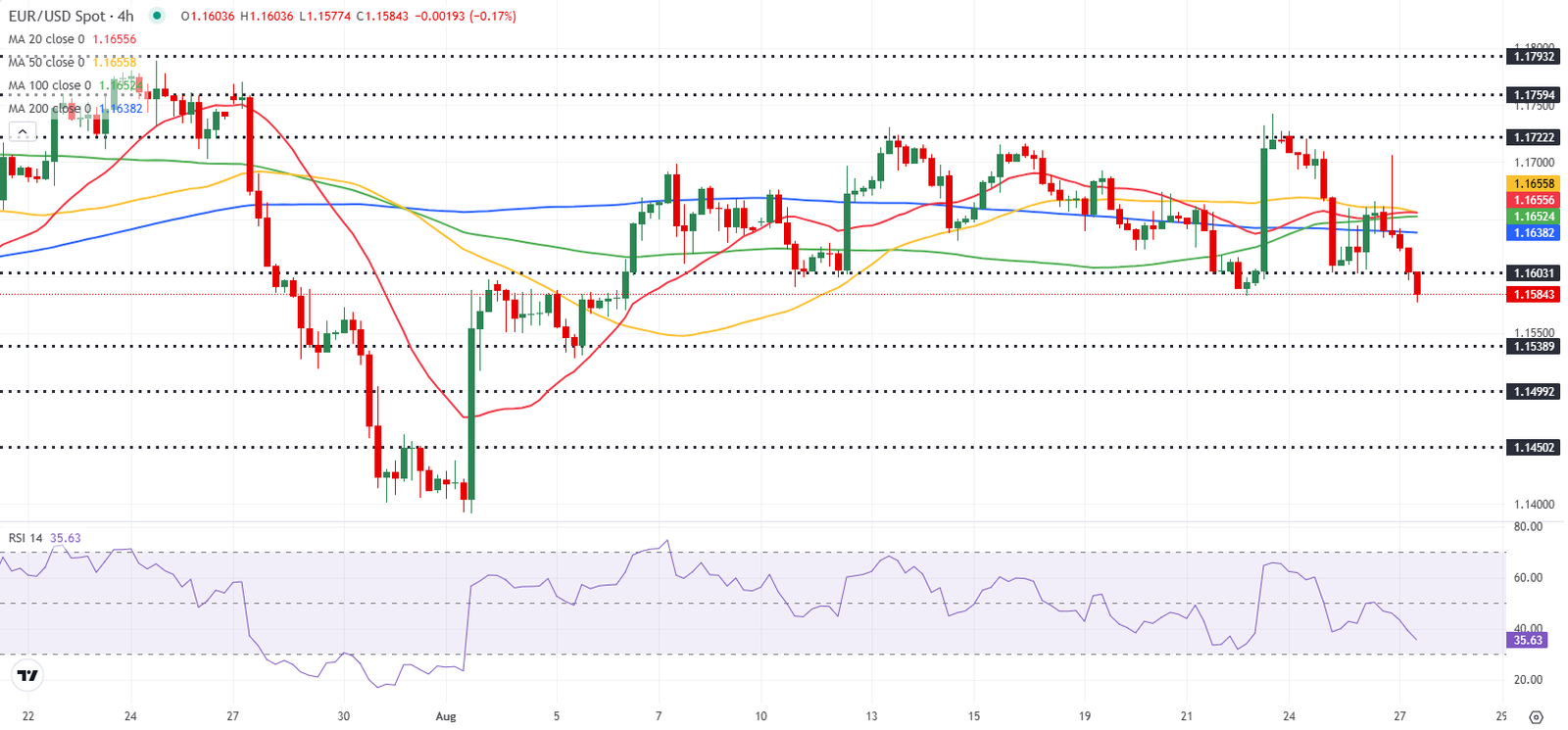- EUR/USD trades in negative territory below 1.1600 early Wednesday.
- The political turmoil in France seems to be weighing on the Euro.
- The near-term technical outlook points to an increasing bearish pressure.
EUR/USD stays under selling pressure following Tuesday’s modest recovery and trades at its lowest level in three weeks below 1.1600 in the European session on Wednesday. The pair’s technical picture highlights a buildup of bearish momentum.
Euro Price This week
The table below shows the percentage change of Euro (EUR) against listed major currencies this week. Euro was the weakest against the US Dollar.
| USD | EUR | GBP | JPY | CAD | AUD | NZD | CHF | |
|---|---|---|---|---|---|---|---|---|
| USD | 1.20% | 0.60% | 0.74% | 0.22% | 0.37% | 0.68% | 0.68% | |
| EUR | -1.20% | -0.59% | -0.51% | -0.96% | -0.75% | -0.52% | -0.51% | |
| GBP | -0.60% | 0.59% | -0.06% | -0.37% | -0.22% | 0.07% | 0.08% | |
| JPY | -0.74% | 0.51% | 0.06% | -0.45% | -0.33% | 0.01% | 0.07% | |
| CAD | -0.22% | 0.96% | 0.37% | 0.45% | 0.17% | 0.48% | 0.46% | |
| AUD | -0.37% | 0.75% | 0.22% | 0.33% | -0.17% | 0.29% | 0.30% | |
| NZD | -0.68% | 0.52% | -0.07% | -0.01% | -0.48% | -0.29% | 0.00% | |
| CHF | -0.68% | 0.51% | -0.08% | -0.07% | -0.46% | -0.30% | -0.01% |
The heat map shows percentage changes of major currencies against each other. The base currency is picked from the left column, while the quote currency is picked from the top row. For example, if you pick the Euro from the left column and move along the horizontal line to the US Dollar, the percentage change displayed in the box will represent EUR (base)/USD (quote).
The escalating feud between United States (US) President Donald Trump and the Federal Reserve made it difficult for the US Dollar (USD) to stay resilient against its rivals on Tuesday and helped EUR/USD hold its ground.
Early Wednesday, however, the political turmoil in France causes the Euro to lose interest. French Prime Minister Francois Bayrou is widely expected to lose the vote of confidence he called for early September after failing to find common ground on an austerity budget and debt-reduction plan.
If Bayrou loses the confidence vote, French President Emmanuel Macron could appoint a new Prime Minister or call for a snap election.
Analysts at ABN Amro think that a snap election in France could have spillover effects across the Eurozone and pave the way for widening bond spreads with other countries.
“If President Macron appoints a new Prime Minister—likely from the centre-left this time—instead of calling for new legislative elections, we do not anticipate a further widening of the 10-year spread,” analysts noted.
In the second half of the day, the US economic calendar will not feature any high-impact macroeconomic data releases. In this market atmosphere, investors could refrain from positioning themselves for a steady recovery in the Euro.
EUR/USD Technical Analysis

The Relative Strength Index (RSI) indicator on the 4-hour chart dropped below 40 and EUR/USD closed the last three 4-hour candles below the 200-period Simple Moving Average (SMA), reflecting a bearish stance.
On the downside, 1.1540 (static level) could be seen as the next support level before 1.1500 (static level, round level) and 1.1450 (static level). Looking north, an interim resistance level could be spotted at 1.1600 (static level, round level) ahead of 1.1640-1.1650 (200-period SMA, 100-period SMA) and 1.1700 (static level, round level).
Euro FAQs
The Euro is the currency for the 19 European Union countries that belong to the Eurozone. It is the second most heavily traded currency in the world behind the US Dollar. In 2022, it accounted for 31% of all foreign exchange transactions, with an average daily turnover of over $2.2 trillion a day.
EUR/USD is the most heavily traded currency pair in the world, accounting for an estimated 30% off all transactions, followed by EUR/JPY (4%), EUR/GBP (3%) and EUR/AUD (2%).
The European Central Bank (ECB) in Frankfurt, Germany, is the reserve bank for the Eurozone. The ECB sets interest rates and manages monetary policy.
The ECB’s primary mandate is to maintain price stability, which means either controlling inflation or stimulating growth. Its primary tool is the raising or lowering of interest rates. Relatively high interest rates – or the expectation of higher rates – will usually benefit the Euro and vice versa.
The ECB Governing Council makes monetary policy decisions at meetings held eight times a year. Decisions are made by heads of the Eurozone national banks and six permanent members, including the President of the ECB, Christine Lagarde.
Eurozone inflation data, measured by the Harmonized Index of Consumer Prices (HICP), is an important econometric for the Euro. If inflation rises more than expected, especially if above the ECB’s 2% target, it obliges the ECB to raise interest rates to bring it back under control.
Relatively high interest rates compared to its counterparts will usually benefit the Euro, as it makes the region more attractive as a place for global investors to park their money.
Data releases gauge the health of the economy and can impact on the Euro. Indicators such as GDP, Manufacturing and Services PMIs, employment, and consumer sentiment surveys can all influence the direction of the single currency.
A strong economy is good for the Euro. Not only does it attract more foreign investment but it may encourage the ECB to put up interest rates, which will directly strengthen the Euro. Otherwise, if economic data is weak, the Euro is likely to fall.
Economic data for the four largest economies in the euro area (Germany, France, Italy and Spain) are especially significant, as they account for 75% of the Eurozone’s economy.
Another significant data release for the Euro is the Trade Balance. This indicator measures the difference between what a country earns from its exports and what it spends on imports over a given period.
If a country produces highly sought after exports then its currency will gain in value purely from the extra demand created from foreign buyers seeking to purchase these goods. Therefore, a positive net Trade Balance strengthens a currency and vice versa for a negative balance.




















